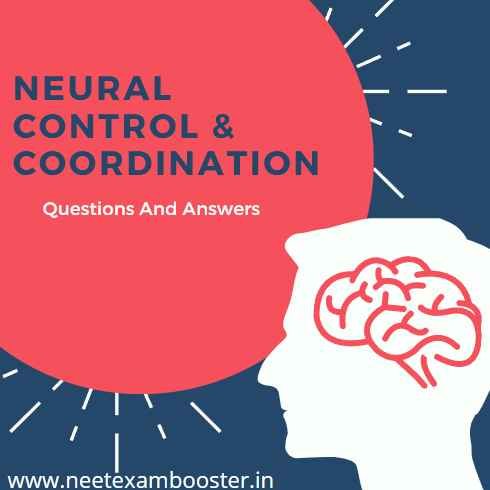Neural Control and Coordination Class 11:- The function of the organs or the organ systems in our body is controlled or coordinated to maintain the homeostasis.Our neural system provides an organised network of point by point connection for the quick coordination.
Biology Important Questions And Answers Chapter 21 Neural Control and Coordination Class 11

Neural Control and Coordination Class 11 – Very Short Answer Type Questions
Q.1. Arrange the following terms in accurate order of their association in the electrical impulse movement – Synaptic knob, Axon terminal, Axon, dendrites, Cell body.
A.1. Dendrites-Cell body-Axon- Axon terminal-Synaptic knob.
Q.2. Write the name of retina cells which allows us to see coloured objects.
A.2. Cone cell is the name of retina cell.They are of three types and have the characteristic of photopigments which react to red, blue, and green light.
Q.3. Rearrange following in the serial order of reception and transmission of sound waves from eardrum –
External auditory nerve, eardrum, cochlear nerve, malleus, stapes, incus, cochlea
A.3.The serial order for the sound waves received and transmitted are: External auditory nerve→ eardrum→malleus→Incus → Stapes → Cochlea → Cochlear nerve.
Q.4. Make a list of the structures which protect the brain.
A.4. Cranium – 8 cranial bones forms hard outer covering for our brain Meninges . Our brain is covered with the three membranes known as meninges. They are the following- pia mater, arachnoid membrane, and dura mater Cerebrospinal fluid . This is present in between the space meninges and absorbs shocks.
Q.5. For what the white and the grey matter in the human brain indicate?
A.5. Cerebral cortex of the brain is called grey matter as it appears as grey in colour that is attributed to neuron cell bodies imparting the colour.The fibres of tracts are covered with myelin sheath which forms the inner part of cerebral hemisphere, to transmit an opaque white appearance to the layer therefore the white colour.
Q.6.In which part of the human brain is the centre for hunger located?
A.6. Hypothalamus is the centre for hunger located
Neural Control and Coordination Class 11 quiz
Q.7.Write the name of the sense organ involved in vertigo.
A.7. Vestibular apparatus of the inner ear is involved in vertigo.
Q.8. Write the name of the three layers of the human eye
A.9. Following are the three layers of the human eye-Lens, Aqueous humour and Vitreous humour.
Q.10. What is the name of the photosensitive part of the human eye?
A.10. Retina is mainly composed of the light-sensitive cells called as the rods and the cones, therefore it is called as the light-sensitive layer which lines interior of the eye.
Neural Control and Coordination Class 11 – Short Answer Type Questions
Q.1. Write the difference between the chemical and the electrical transmission.
A.1. Following are the difference:
| Electrical Transmission | Chemical Transmission |
| It takes place in an electric synapse. | It take place at the chemical synapse. |
| The presence of synaptic cleft may or may not be . | Synaptic cleft is also present. |
| Electric current at the electrical synapses flows from one to another neuron by these synapses.The Impulse transmission across an electrical transmission is always fast. | Neurotransmitter at chemical synapse from presynaptic neurons transfers to postsynaptic neurons which cause transmission of impulse.The chemical transmission is slower. |
Q.2. What are the similarities between the computers and the neural system.
A.2. Our various organs have sensory neurons that sense surroundings and the send across the communication to brain that is similar to input device in the computers. Our human brain can be compared to Central Processing Unit (CPU). The data which is gathered by sensory neurons that is processed by the brain which further commands specific organ to work in accordance. And finally, message is picked by motor neurons which is similar to output devices.
Q.3.If he is attacked by a blow on back of the neck of person , how could it affect a person’s CNS .
A.3. It leads to transmission of the cognitive abilities or dysfunctionalities physically. It can also cause the disturbance of emotional or the behavioural functioning.The cervical damages can be lead to tetraplegia.
Q.4. Write the role of attributed to the Eustachian tube.
A.4. Eustachian tube connects pharynx with middle ear cavity and the aids in equalizing the pressures on both parts of the eardrum. A valve is present towards pharyngeal opening of tube which remains closed usually. Eustachian tube during the swallowing, yawning, or an unexpected change in altitude when air leaves or enters tympanic cavity so as to stabilize air pressure on both the parts of the tympanic membrane.
Q.5.Write the functions of Eustachian tube.
A.5.
Following are the functions of Eustachian tube:
- It facilitates secretion drainage from middle ear.
- With the nasopharynx it connects the middle ear cavity.
- It equalize pressure between the middle ear and the atmosphere.
Neural Control and Coordination Class 11 – Long Answer Type Questions
Q.1. Explain phenomena of the release and the transport of a neurotransmitter.
A.1. The synapses is the junctions that transmits the nerve impulses from one to the another neuron. It is produced through the membranes of the postsynaptic and presynaptic neuron that may be or may not be parted by a synaptic cleft which is a gap. The membranes of presynaptic and postsynaptic neurons at the chemical synapse are divided by a space which is filled with fluid called as the synaptic cleft. The neurotransmitters transmit impulses at such synapses. Axon terminals possess vesicles which have the neurotransmitters.
When the impulse arrives, and it reaches axon terminal and triggers action of the synaptic vesicles supports to the membrane wherein it join with the plasma membrane to produce their neurotransmitters, all in synaptic cleft, that in turn attach to the particular receptors situated on the postsynaptic membrane. The union of ion channels permits the entrance of ions which can produce a new potential in the postsynaptic neuron which can either be inhibitory or excitatory.
Neural Control and Coordination Class 11 study materials
Q.2. Explain the structure of the internal and middle ear.
A.3. The Ears are a pair of the statoacoustic organ which helps in balancing and hearing. Our human ear includes – middle ear,inner ear, and internal ear. Pinna is a part of our auditory system and forms external ear. Middle ear has 3 bones – malleus(hammer), stapes(stirrup) and incus(anvil) that are attached in chain-like pattern. Stapes is connected to oval window of cochlea and malleus is connected to tympanic membrane. The three bones or ossicles raises productivity of the communication of sound waves to inner ear. Middle ear leads to the Eustachian tube that bridges along with pharynx and controls force between outside and the middle ear.
Inner ear consists of a labyrinth of chambers filled with fluids inside temporal bone of skull. The labyrinth is up of 2 parts – membranous and bony labyrinth .Inside channels lies with the membranous labyrinth that is girdled by a fluid called as perilymph and filled with a fluid known as endolymph. Labyrinth have a coiled structure known as the cochlea. That has 2 large canals – the upper vestibular canal and the lower tympanic canal which is divided by a small cochlear duct. Both the canals contain perilymph with the endolymph in cochlear duct. Base of the scala vestibuli is towards, membranous labyrinth walls are sync with fenestra ovalis and at lower end of scala tympani is the fenestra rotunda.
Click here to join our telegram channel for more study materials like Neural Control and Coordination Class 11



















